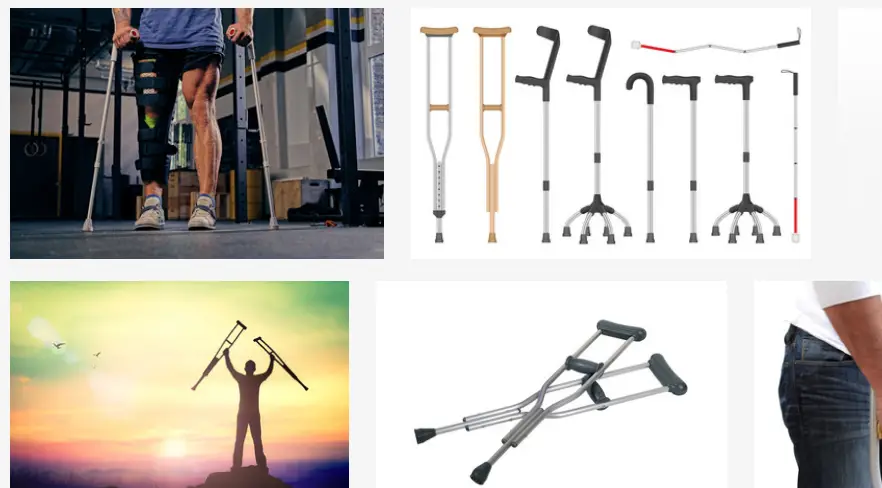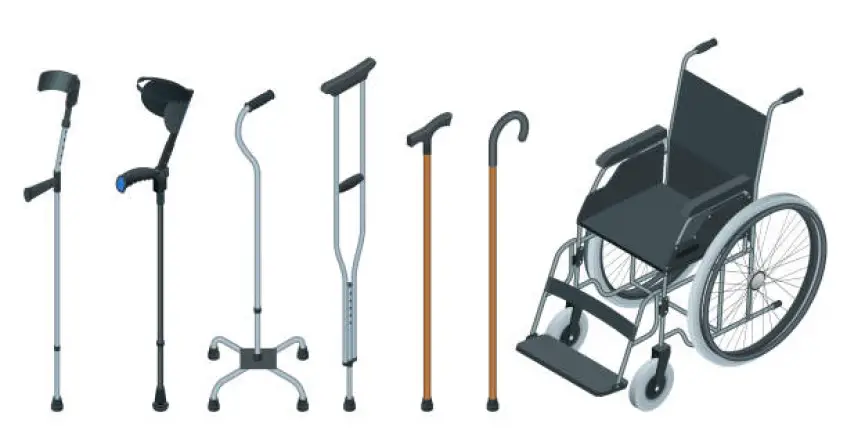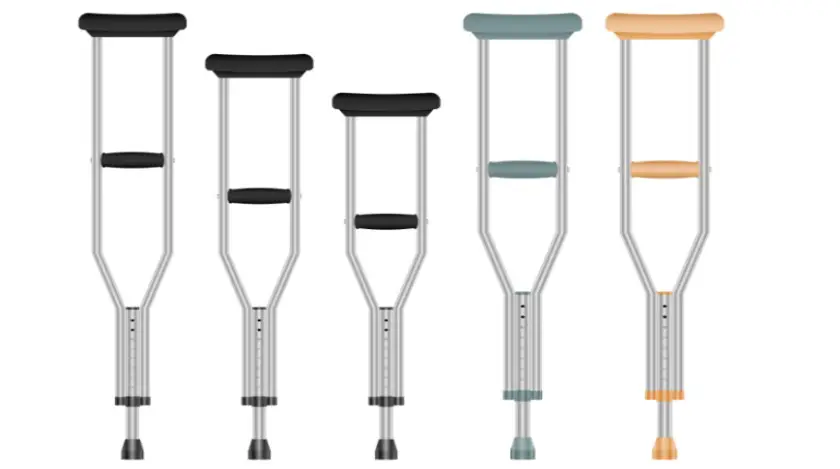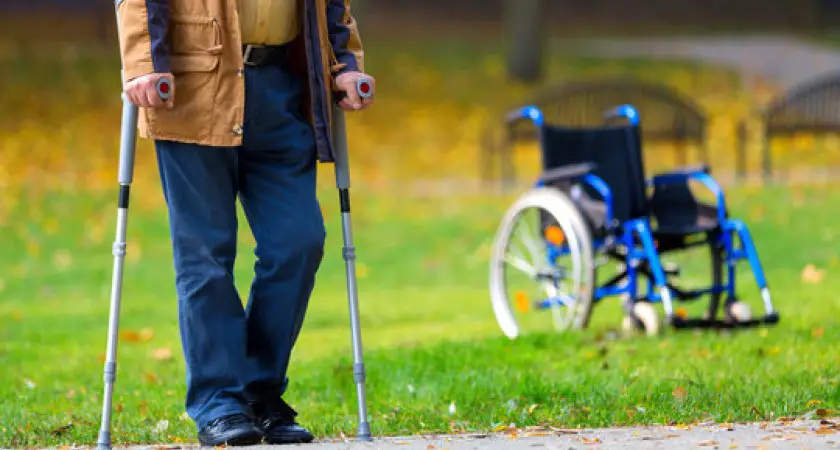Crutches haven’t changed much over the years but are featuring more functionalities as time passes.
With the help of technology, they are now being developed to offer maximum support and keep the hands free.
This is a vital innovation that enables injured persons to go about their daily activities and catch fun even with their injuries.
Crutches provide more support than canes because they have the capability of accommodating more weight.
There are different types of crutches. Even though they serve the same purpose of making mobility easy, each one has a unique feature that makes it differ from the other.
Table of Contents
4 Types of Crutches
Below are the major types of crutches available. I’ve included enough details about each one and some tips to help you to determine which one is best for you. Depending on your injury and the level of support you need, you may have the option to choose any of them or be restricted to a few choices.
1 Forearm Crutch
Forearm crutches are also known as elbow crutches or Lofstrand crutches.
This type of crutch has a cuff at the top and a grip a few inches beneath it. It is used by inserting the arm in the cuff and holding the grip firm. The cuff is usually made of plastic or metal and is situated at the top of the grip. Some cuffs are opened halfway while others are almost completely closed. The closed ones often have a v-shaped opening that allows you to quickly remove your arm in case of a fall.
The elbow crutch is mostly used by individuals with permanent or long-term disabilities. You need some physical strength in your upper body to be able to use it conveniently.
Using a forearm crutch for the first time can be challenging. Your hands will hurt real bad after the first use if you use it barehanded. You can, however, avoid or reduce this effect by wearing a well-padded glove before using it. A cycling glove is a good choice.
The forearm crutch has some advantages over other types. The cuffs allow them to stay in your forearm when you need to free your hands. You won’t need to look for a place to lean your crutch when you need to take a break or focus on something else for a few moments.
Related: 10 Best Software for Low Vision Students
2 Underarm/Axillary Crutch
This type of crutch is used by placing it under the armpit and exerting your weight on it. It is very useful if you don’t have enough strength in your upper body and can’t balance and align yourself.
It is easy to use and feels comfortable when you master it. It, however, requires you to fit it correctly and position well to avoid some side effects like developing armpit injury or hunch back.
Depending on the type you’re using, you may consider using them with towels before placing them under your armpits to prevent injuries. Some crutches come with comfy armpit pads that can be easily removed and washed. They also have palm pads to prevent your hands from hurting after long-term use.
The most important thing to consider when choosing an underarm crutch is the paddings of where you’ll place your arm and hand. This is the main feature that determines how comfortable your mobility aid will feel while using it.
The heights are usually adjustable. So, if you get a crutch with very thick pads and you’re not tall, you can easily adjust it to fit your height.
Axillary crutches are usually used for short-term injuries and disabilities.
3 Platform Crutch
The platform crutch is a modified version of the forearm crutch. It is designed to evenly distribute your weight along the forearm without exerting much pressure on your wrist. This is mostly recommended for people with arthritis or low grip strength.
With the platform crutch, your arm is horizontally placed on a platform and strapped firmly to keep it stable. An angled grip is present right where your hand shoots out for firmer support. The platform crutch is very convenient and easy to use; it doesn’t cause you any underarm or wrist pain since your weight is evenly distributed.
Newer platform crutches are designed to be a positive addition for therapy. They can be attached to walkers to provide more comfort and act as a solution for quick recovery. They can be used as extra support to walkers so that you can stand upright while walking and won’t have to bend over.
This type of crutch is suitable if you’ve had a fixed hip, fixed wrist, arthritis, or you get tired easily and feel fatigued on your shoulder or elbow while using walkers.
Just like other types of crutches, the platform crutches can also be easily adjusted to fit your height.
Related: Top 10 Text Readers for the Visually Impaired
4 Hands-Free Knee Crutch
This is an innovation that’s quite different from other crutches. It provides support to a person with injuries on the lower part of one of the legs. It is used by strapping the crutch on the affected leg and folding the leg towards the front or back. The crutch leaves your hands free and allows you to navigate easily and go about your daily routine.
There are requirements that need to be met before you can use this crutch. Your injury has to be a non-weight bearing lower leg injury. This means that you can’t use it if you have an injury or just had surgery on the pelvis, hip, thigh, or knee. It is a very good fit for people with injury on the ankle.
Basically, it’s suitable for use if your injury falls below your knee and your injured leg can bend up to 90-degrees. Also, you must be able to move easily while resting on your other leg.
This is a very useful crutch that gives you more freedom and quick recovery with far less pain compared with other crutches. Using the hands-free knee crutch, you can go shopping and even engage in certain sports with little or no limitations.
Wrap Up
Choosing a crutch can be tricky because each type has its pros and cons. The way out is to weigh your options and choose a winner. What you want is a crutch that will get the job done effectively with less effort. The nature of your injury and the level of support you need are major determinants of the type of crutch you should use.
Compare Mobility Aids
- Top 10 Free Software for Visually Impaired Students
- 10 Best Text Readers for the Blind
- Best Mobility Aids Walkers for Easy Movement
- Major Benefits of Mobility Aids
- 9 Best Disability Products for Seniors
- List of Baby Products for Disabled Parents
- Top Recommended Kitchen Tools for Onehanded
- How to Adjust Your Crutches to Your Height Properly
- How to Make Your Crutches Not Slip
- How to Pad Crutches with Socks (DIY)



